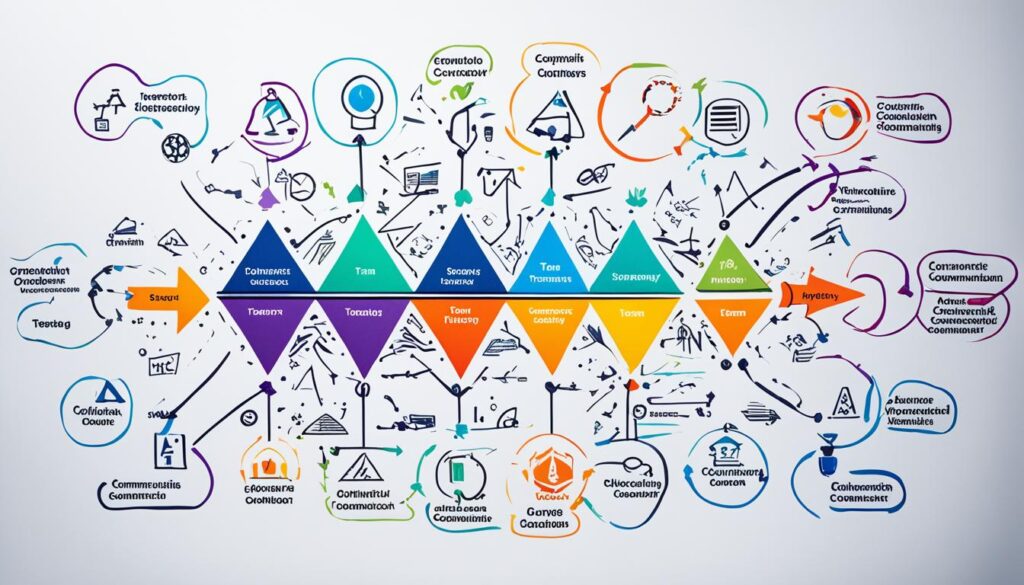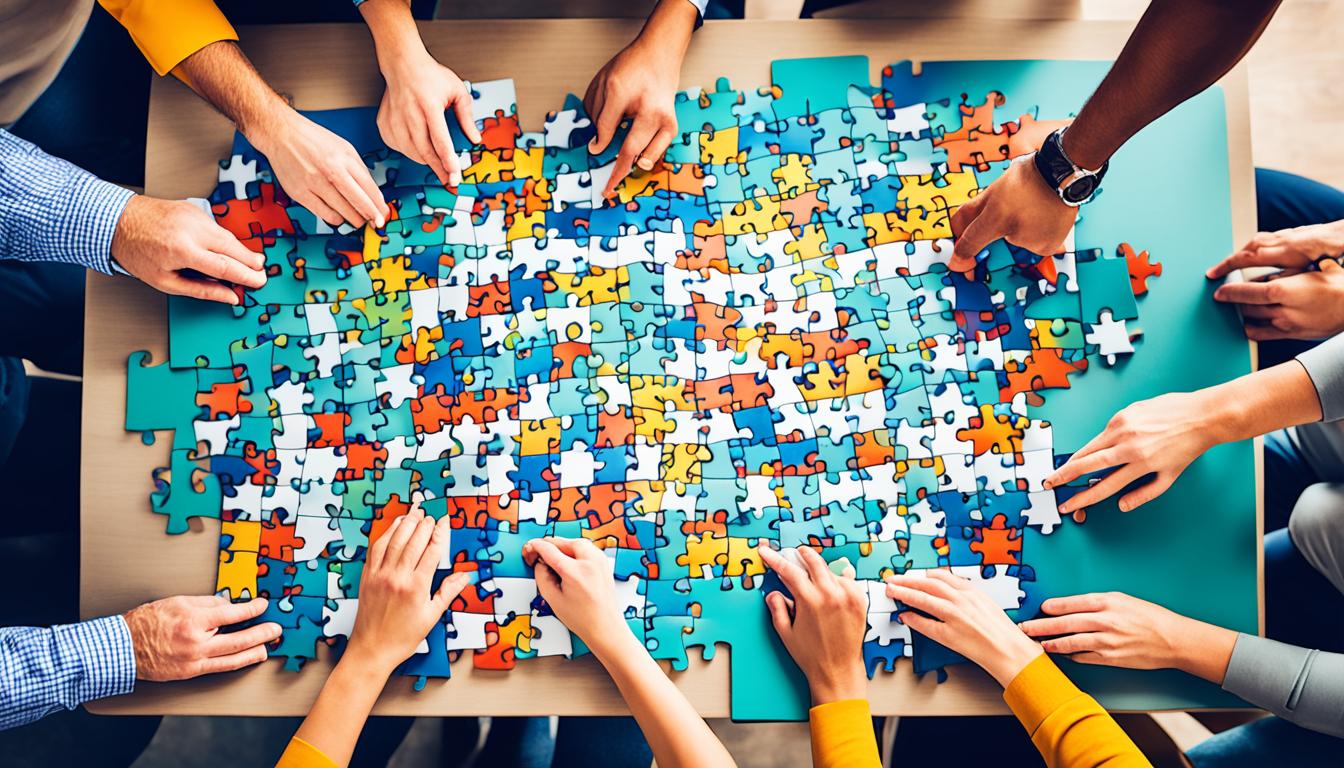Team dynamics can make or break a project. Imagine a team of highly talented individuals working together on a crucial deadline. On paper, they have all the skills and knowledge required. However, when it comes to actually collaborating and achieving their goals, they face numerous challenges.
In this situation, the team members find themselves struggling to communicate effectively, leading to miscommunication and misunderstandings. Their different working styles and personalities clash, impacting their ability to work cohesively. As a result, team productivity suffers, and the project falls behind.
This scenario is one that many of us can relate to. Whether it’s in the workplace, a sports team, or a community project, team dynamics are an essential aspect of our everyday lives. Understanding and managing team dynamics is the key to unlocking the full potential of any team.
Key Takeaways:
- Effective teamwork practices are crucial for successful collaboration.
- Improving team communication is vital for fostering positive team dynamics.
- Group cohesion techniques can enhance team performance.
- Team dynamics are influenced by factors such as team size, diversity, and leadership style.
- Assessment tools can help gauge and improve team dynamics.
The Importance of Teamwork and Communication
Effective teamwork and communication are fundamental for fostering positive team dynamics. These critical aspects contribute to a collaborative and productive team environment. To achieve successful collaboration, it is crucial to understand and apply group dynamics principles and recognize the individual temperaments within the team.
One commonly used model to understand team development is Tuckman’s Stages of Group Development. This model outlines four stages that teams typically progress through: forming, storming, norming, and performing. At each stage, effective communication plays a vital role in establishing clear expectations and guidelines for team members.
“Individual commitment to a group effort – that is what makes a team work, a company work, a society work, a civilization work.”
Clear communication is essential during the forming stage to set the team’s direction and goals. It helps to establish trust and build a foundation for effective collaboration. As the team moves into the storming stage, communication becomes crucial in addressing conflicts, addressing different perspectives, and finding resolutions.
During the norming stage, communication assists in establishing group cohesion and defining roles and responsibilities. Finally, in the performing stage, effective communication ensures smooth and efficient collaboration, leading to the successful achievement of team goals.
Aside from Tuckman’s model, other techniques like DISC theory and the GRPI model can also provide valuable insights into team dynamics and conflict management. These models help identify individual strengths and weaknesses, improve communication styles, and enhance team dynamics to ensure effective collaboration.
By promoting effective teamwork practices and improving team communication, organizations can enhance team performance, productivity, and overall success.
Factors Influencing Team Dynamics
Team dynamics are shaped by various factors that can have a profound impact on the overall effectiveness and productivity of a team. Understanding these factors is essential for creating a cohesive and high-performing team. In this section, we will explore the key elements that influence team dynamics and how they can affect team performance. One crucial element is clear communication, which fosters trust and transparency among team members. Additionally, defined roles and responsibilities help minimize confusion and create a sense of accountability. By recognizing and cultivating positive team dynamics for effective collaboration, organizations can enhance their teams’ ability to adapt, innovate, and achieve their goals efficiently.
1. Team Size
The size of a team can significantly affect its dynamics. Larger teams often face challenges in effective communication and coordination. With more members, it can become harder to ensure that everyone is on the same page and working towards a common goal. On the other hand, smaller teams may struggle with task completion due to limited resources and expertise.
2. Diversity
Diversity within a team brings different perspectives and skills to the table, which can lead to innovative ideas and problem-solving. However, it can also introduce conflicts and challenges in terms of communication and collaboration. Managing diversity requires creating an inclusive environment where team members respect and value each other’s differences.
3. Leadership Style
The leadership style adopted within a team plays a crucial role in shaping its dynamics. Effective leaders establish clear goals, provide guidance and support, and promote open communication. A positive leadership style fosters trust and collaboration among team members, contributing to a healthy work environment.
4. External Factors
External factors such as market trends, competition, and organizational changes can have a significant impact on team dynamics. These factors can introduce stress and tensions within the team, affecting communication, collaboration, and overall team performance. Adapting to these external factors requires flexibility and effective communication strategies.
By understanding and acknowledging these factors that influence team dynamics, organizations can implement strategies to improve collaboration, enhance team performance, and achieve their goals.

The Role of Leadership in Team Dynamics
Effective leadership plays a vital role in fostering positive team dynamics. When leaders establish clear roles and responsibilities, provide support and feedback, and promote open communication and trust within the team, they create an environment conducive to collaboration and productivity.
One key aspect of effective leadership in team dynamics is ensuring that all team members have a clear understanding of their roles and responsibilities. By clarifying expectations and setting achievable goals, leaders empower their team to work towards a common objective.
“Leadership is not about being in charge. It is about taking care of those in your charge.”
Leaders should also prioritize improving team communication. By encouraging open and transparent dialogue, leaders create an environment where ideas can be shared, conflicts can be addressed, and solutions can be found collaboratively.
Feedback is another crucial element of effective leadership. Regularly providing constructive feedback and recognizing team members’ achievements can enhance team performance and promote a culture of continuous improvement.
Accountability is a fundamental principle in team dynamics. Leaders must hold team members accountable for their actions and their commitment to the team’s goals. By establishing clear expectations and consequences, leaders create a sense of responsibility and drive individual and collective performance.
Ultimately, effective leadership in team dynamics is about creating a supportive and empowering environment where team members feel valued, motivated, and engaged. When leaders prioritize team productivity strategies, improving team communication, and enhancing team performance, they set their team up for success.

| Leadership Strategies | Impact on Team Dynamics |
|---|---|
| Establishing clear roles and responsibilities | Creates a sense of direction and accountability |
| Promoting open communication and trust | Fosters collaboration and effective problem-solving |
| Providing feedback and recognition | Enhances individual and team performance |
| Holding team members accountable | Drives responsibility and results |
Best Practices for Fostering Positive Team Dynamics
To create a positive team dynamic, it is crucial to implement effective teamwork practices, successful collaboration methods, and improve team communication. Follow these best practices to enhance team performance and build a strong and cohesive team.
1. Establish Clear Goals and Expectations
Setting clear goals and expectations is essential for guiding team members towards a common objective. Clearly define project milestones, deadlines, and individual responsibilities. This clarity will help the team stay focused, aligned, and motivated.
2. Promote Open Communication Channels
Effective communication is the foundation of successful collaboration. Encourage team members to actively share their ideas and concerns, fostering an environment of open dialogue. This inclusivity allows for diverse perspectives and innovative solutions to flourish.
3. Embrace Diversity and Inclusion
Diversity brings different skillsets, experiences, and perspectives to the table, enhancing problem-solving abilities and fostering creativity. Embrace diversity and ensure that all team members feel included and valued for their contributions. This inclusion will lead to a stronger and more resilient team.
4. Implement Team Building Activities
Engage in team building activities to foster trust, collaboration, and camaraderie among team members. These activities can include group outings, team-building workshops, or virtual team-building exercises. Fun and interactive experiences help build relationships and strengthen the bond within the team.
Blockquote>
“Team building activities can help build trust and improve collaboration.”
5. Provide Regular Feedback and Recognition
Regular feedback and recognition are crucial for maintaining team morale and motivation. Acknowledge and appreciate individual and team achievements openly. Constructive feedback can also help team members grow and improve their performance.
6. Foster a Positive Team Culture
Create a positive team culture by encouraging collaboration, respect, and open-mindedness. Foster a supportive environment where all team members feel comfortable sharing their thoughts and ideas. Encourage a growth mindset, emphasizing continuous learning and development.
| Benefits of Team Building Activities | Examples of Team Building Activities |
|---|---|
| Enhances communication | Escape room challenges |
| Builds trust and camaraderie | Outdoor adventure activities |
| Improves problem-solving skills | Team sports or games |
| Boosts creativity and innovation | Collaborative art projects |
By incorporating these best practices into your team’s daily operations, you can cultivate a positive team dynamic, improve collaboration, and enhance overall performance.
Overcoming Common Challenges in Team Dynamics
While team dynamics can greatly enhance collaboration and performance, they can also encounter numerous challenges. It is essential for teams to address these challenges promptly and effectively in order to maintain productivity and a positive work environment. Some of the common challenges in team dynamics include conflicts, misunderstandings, and team member turnover.
Conflicts: Conflict resolution is key to restoring harmony within teams. By providing conflict resolution training and promoting open communication channels, teams can address conflicts in a constructive manner. Encouraging active listening and fostering a collaborative mindset can foster understanding and lead to effective conflict resolution.
Misunderstandings: Clear communication channels are crucial to avoid misunderstandings. Teams should establish common ground for effective communication and ensure that expectations are communicated clearly. Active listening and promoting open dialogue can help prevent misunderstandings and improve overall team communication.
Team member turnover: Managing team member turnover is crucial to maintaining team morale and productivity. By implementing strategies such as proper onboarding processes, ongoing training and development opportunities, and effective talent management practices, teams can minimize the disruptions caused by team member turnover and ensure the continuity of team dynamics.
To overcome these common challenges, teams should prioritize team productivity strategies, improving team communication, enhancing team performance, and team conflict resolution. By proactively addressing these challenges, teams can create a positive and supportive team dynamic that promotes collaboration, productivity, and overall success.
| Challenge | Strategies |
|---|---|
| Conflicts | – Provide conflict resolution training – Promote open communication channels – Encourage active listening – Foster a collaborative mindset |
| Misunderstandings | – Establish clear communication channels – Define and communicate expectations clearly – Encourage active listening and open dialogue |
| Team member turnover | – Implement effective onboarding processes – Provide ongoing training and development opportunities – Practice effective talent management |
Conclusion
Team dynamics are crucial for the success of any team. By understanding the key elements of a team dynamics framework and implementing effective teamwork practices, teams can enhance their performance, improve collaboration, and achieve their goals. Strong communication, mutual respect, and clearly defined roles are essential components that contribute to positive team dynamics in the workplace. When team members feel valued and are encouraged to share their ideas, it fosters a culture of innovation and accountability. By prioritizing these aspects, organizations can cultivate an environment where team dynamics flourish, leading to greater overall success.
Leadership plays a crucial role in fostering positive team dynamics. Effective leaders establish clear roles and responsibilities, promote open communication and trust, and provide support and feedback to team members. By creating a supportive and empowering environment, leaders can enhance team performance and engagement.
Addressing common challenges in team dynamics is essential for maintaining a healthy and productive team environment. Conflict resolution training, clear communication channels, and active listening can help overcome conflicts and misunderstandings. Effective management of team member turnover is also important to avoid disruptions and maintain team morale.
By prioritizing team dynamics and implementing successful collaboration methods, organizations can drive success and achieve their desired outcomes. By establishing clear goals, promoting open communication, and fostering diversity and inclusion, teams can create a positive and productive work environment. Continuously assessing and enhancing team dynamics will lead to improved teamwork, enhanced performance, and overall organizational success.
FAQ
What is team dynamics?
Team dynamics refers to the interactions, relationships, and communication patterns among team members. It plays a crucial role in the success of any team.
Why is effective teamwork and communication important for team dynamics?
Effective teamwork and communication are essential for positive team dynamics. They help in understanding group dynamics and individual temperaments within the team, fostering collaboration and synergy.
What factors influence team dynamics?
Several factors can influence team dynamics, including team size, diversity, leadership style, and external factors such as market trends and competition.
What is the role of leadership in team dynamics?
Leadership plays a vital role in fostering positive team dynamics. Leaders need to establish clear roles and responsibilities, provide support and feedback, and promote open communication and trust within the team.
What are the best practices for fostering positive team dynamics?
To foster positive team dynamics, it is important to establish clear goals and expectations, promote diversity and inclusion, encourage open communication, and engage in team building activities.
How can common challenges in team dynamics be overcome?
Common challenges in team dynamics, such as conflicts, misunderstandings, and team member turnover, can be overcome through effective conflict resolution, clear communication channels, and proper management of team member turnover.
How can team dynamics contribute to team success?
By understanding the key elements of a team dynamics framework and implementing effective teamwork practices, teams can enhance their performance, improve collaboration, and achieve their goals.


